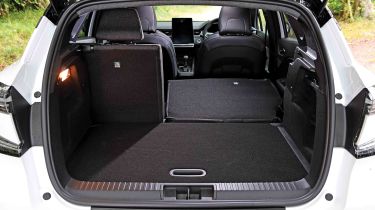Renault Captur - Boot space, comfort & practicality
The Renault Captur makes the most of its interior space with some clever storage touches

The second-generation Captur sits on the same CMF-B platform as the latest Renault Clio and it’s 110mm longer, 19mm wider and 17mm taller than the original model. The new platform and bigger dimensions have brought gains in passenger space and practicality, helping the Captur attract customers with growing families. Usefully, each door can take a 1.5-litre water bottle, and there’s good storage for cups and phones – including a wireless charging plate.
Access for passengers at the rear is good, and noticeably better than the Peugeot 2008, which has a lower roofline. The rear seats in the Captur are also more comfortable than those in the Ford Puma where you have to sit higher up with your legs tucked back.
|
Dimensions | |
|---|---|
|
Length |
4,239mm |
|
Width |
1,797mm (2,004mm inc mirrors) |
|
Height |
1,575mm |
|
Number of seats |
5 |
|
Boot space |
422-1,276mm (petrol), 326-1,276mm (E-Tech hybrid) |
Dimensions & size
The overall length of the Captur has increased to 4,239mm, with a width of 1,797mm (excluding mirrors) and a height of 1,575mm. In comparison, the Ford Puma is 20mm shorter, 8mm wider and stands 1,537mm tall, while the Peugeot 2008 is 4,300mm long, 1,770mm wide and 1,550mm in height.
How practical is the Renault Captur?
Seats & space in the front
There’s plenty of adjustment in both the driver’s seat and steering wheel, giving lots of scope for getting comfortable in what is quite a lofty seating position for a small SUV. However, storage is a bit of a mixed bag, with the raised centre console opening up space for a large storage area below, including a pair of cup-holders. However, the glovebox capacity is impacted by the fuse box, and the door bins are fairly slim.
Seats & space in the back
Interior space is excellent for passengers, with lots of headroom backed up by above average kneeroom for the segment. There’s more space to stretch your legs out here than in a Jeep Avenger or a Nissan Juke, if not quite as much as in a Skoda Kamiq or a Dacia Duster. Foot room is also excellent under the front seats.
Unusually in this class, the Captur comes with a sliding rear bench. It offers benefits for boot space, but with it moved all the way forward, it all but completely eliminates rear kneeroom. ISOFIX points are hidden behind zips, which makes them a bit fiddly to access.
Boot space
The 422-litre luggage area is reasonably sized, if not class-leading, but the sliding rear seat bench sets it apart from rivals. Move it all the way forward, and the total volume grows to a huge 536 litres, but that renders the back seats pretty much useless for anyone but very young children.
That boot space benefits from plenty of under-floor storage, but it’s a slightly uneven shape. The load lip is also quite high, which makes lifting heavier items on board a bit more difficult than in some rivals.
Towing
Both the TCe 90 has a maximum braked towing weight of 1,200kg, while the hybrid has a reduced rating of 750kg.




